Indexed In
- Open J Gate
- Genamics JournalSeek
- Academic Keys
- ResearchBible
- RefSeek
- Directory of Research Journal Indexing (DRJI)
- Hamdard University
- EBSCO A-Z
- OCLC- WorldCat
- Scholarsteer
- Publons
- Euro Pub
- Google Scholar
Useful Links
Share This Page
Journal Flyer

Open Access Journals
- Agri and Aquaculture
- Biochemistry
- Bioinformatics & Systems Biology
- Business & Management
- Chemistry
- Clinical Sciences
- Engineering
- Food & Nutrition
- General Science
- Genetics & Molecular Biology
- Immunology & Microbiology
- Medical Sciences
- Neuroscience & Psychology
- Nursing & Health Care
- Pharmaceutical Sciences
Commentary - (2024) Volume 12, Issue 4
Metabolic Regulation of Epithelial Cells: Exploring the Role of HCAR3 in Proliferation and Migration
Olivia Carter*Received: 29-Nov-2024, Manuscript No. BEG-24-28106; Editor assigned: 02-Dec-2024, Pre QC No. BEG-24-28106 (PQ); Reviewed: 16-Dec-2024, QC No. BEG-24-28106; Revised: 23-Dec-2024, Manuscript No. BEG-24-28106 (R); Published: 30-Dec-2024, DOI: 10.35248/2167-7662.24.12.278
Description
The study of G-protein-coupled receptors (GPCRs) has led to innovative discoveries in understanding how cells communicate and regulate their responses to external stimuli. Among the many GPCRs, metabolite receptors have attracted increasing attention due to their involvement in regulating various cellular processes, particularly in relation to metabolism, tissue homeostasis and disease progression. One such receptor, HCAR3 (Hydroxycarboxylic Acid Receptor 3), has become a critical player in regulating the behaviors of epithelial cells. In this study, we are going to discuss about the role for HCAR3 in regulating three fundamental processes proliferation, migration and cellular respiration in epithelial cells. By employing a GPCR screening approach, the researchers provide compelling evidence of HCAR3’s involvement in these processes and open up new methods for future research into its potential therapeutic applications.
The epithelium, the tissue layer that forms the outer surface of organs and lines various body cavities, is essential for numerous biological processes. These include tissue repair, immune function and the protection of underlying tissues from external pathogens or environmental stressors. Epithelial cell proliferation and migration are tightly regulated events, both of which are essential during tissue remodeling, wound healing and the response to injury. Dysregulation of these processes can lead to a wide array of diseases, including cancer, fibrosis and chronic inflammatory conditions. The recent discovery of HCAR3’s involvement in regulating these processes has significant implications for our understanding of epithelial biology and could provide new insights into therapeutic strategies for treating diseases associated with epithelial dysfunction.
HCAR3 is part of a group of GPCRs that respond to metabolites, specifically hydroxycarboxylic acids such as lactate, which are byproducts of cellular metabolism. It is well known that metabolism is complexly linked to cellular behavior. For example, in cancer, changed metabolism, characterized by an increased reliance on glycolysis even in the presence of oxygen (a phenomenon known as the Warburg effect), supports the rapid proliferation of tumor cells. In the case of epithelial cells, metabolic pathways may similarly influence cell growth and movement. The study in question highlights HCAR3’s role in mediating these processes by activating specific signaling pathways in response to metabolic cues, making it a main receptor in regulating the cellular functions that determine the fate of epithelial cells.
Moreover, HCAR3’s involvement in cellular respiration is an exciting and novel aspect of the study. Cellular respiration is the process by which cells generate energy in the form of ATP, which is important for maintaining cellular function and supporting processes like proliferation and migration. The fact that HCAR3 modulates cellular respiration suggests that it may play a significant role in the broader metabolic reprogramming of epithelial cells. In particular, this link between HCAR3 and cellular respiration may provide new insights into how metabolic changes influence cell behavior in pathological conditions. Given the growing interest in targeting metabolic pathways in cancer and other diseases, HCAR3 could represent a potential therapeutic target for modulating energy production and cellular activity in disease contexts.
The findings of this study also hold potential for therapeutic applications in a variety of disease settings. For example, cancer therapies that target GPCRs are a growing area of interest and HCAR3’s role in promoting epithelial cell proliferation, migration and respiration positions it as a potential target for such treatments. By modulating HCAR3 signaling, it may be possible to influence tumor growth and metastasis. Additionally, in chronic inflammatory diseases, where excessive epithelial cell migration and proliferation contribute to tissue damage, HCAR3 may offer a novel target for regulating these processes and promoting healing.
The study’s results also create the path for future research into the potential use of HCAR3 as a biomarker for various diseases. For example, the activation status of HCAR3 could serve as an indicator of disease progression or response to treatment in cancer or inflammatory disorders. Furthermore, understanding how HCAR3 interacts with other cellular pathways, including growth factor signaling and the extracellular matrix, could provide a more comprehensive understanding of its role in regulating epithelial behavior.
In conclusion, this study highlights the significant role of HCAR3 in regulating key epithelial cell functions, including proliferation, migration and cellular respiration. The discovery of HCAR3’s involvement in these processes opens up new methods for research into its potential as a therapeutic target for diseases such as cancer and chronic inflammation. As we continue to investigate the complex relationship between metabolism, cell behavior and disease, HCAR3 stands out as an important factor that may contribute to novel treatment strategies aimed at restoring tissue homeostasis and improving patient outcomes.
Citation: Carter O (2024). Metabolic Regulation of Epithelial Cells: Exploring the Role of HCAR3 in Proliferation and Migration. J Bio Energetics. 12:278.
Copyright: © 2024 Carter O. This is an open access article distributed under the terms of the Creative Commons Attribution License, which permits unrestricted use, distribution, and reproduction in any medium, provided the original author and source are credited.
